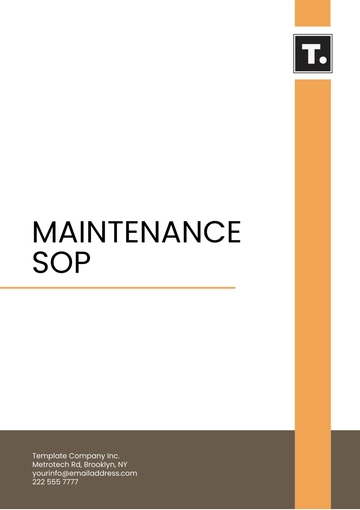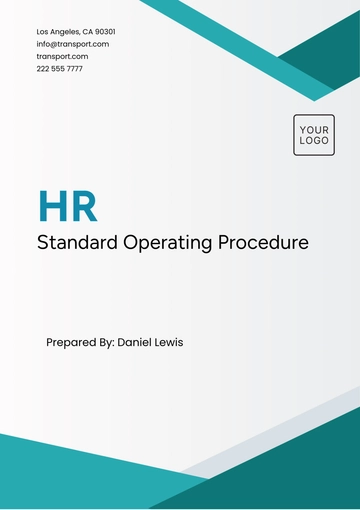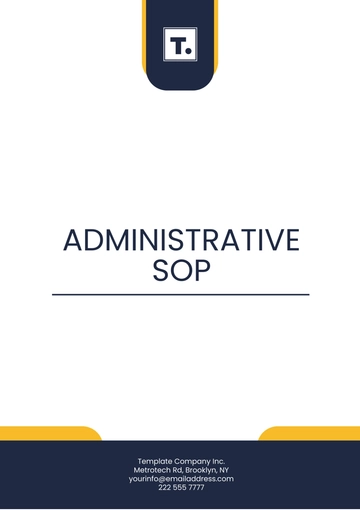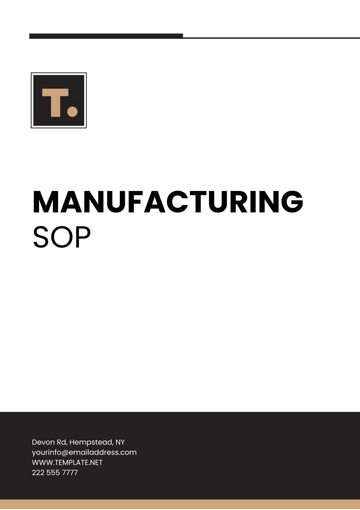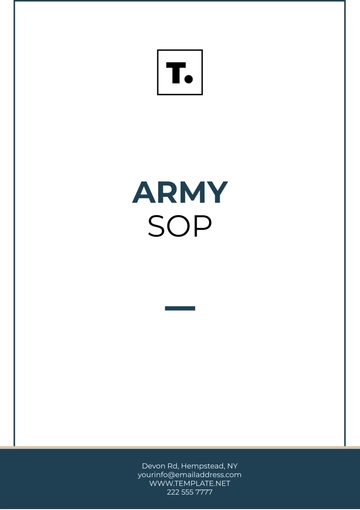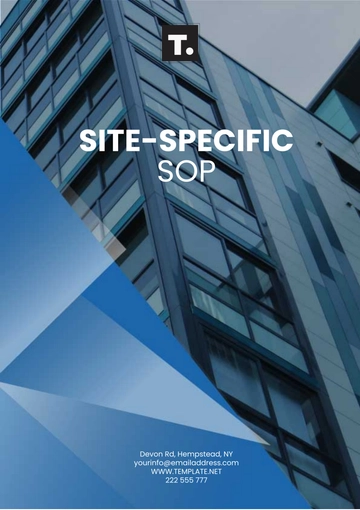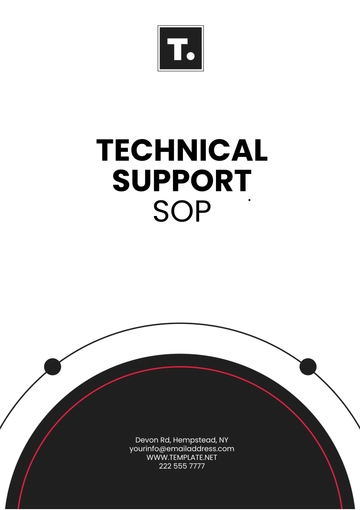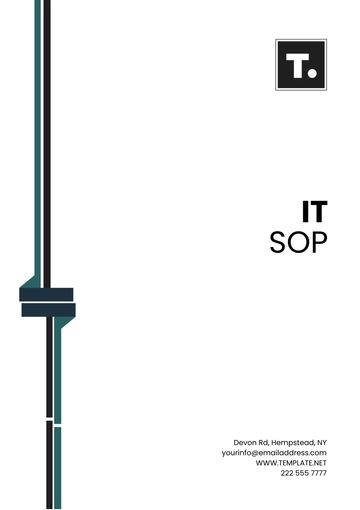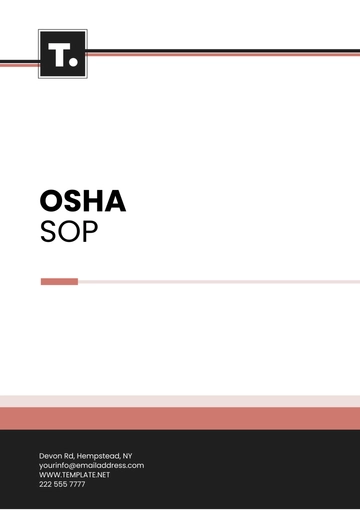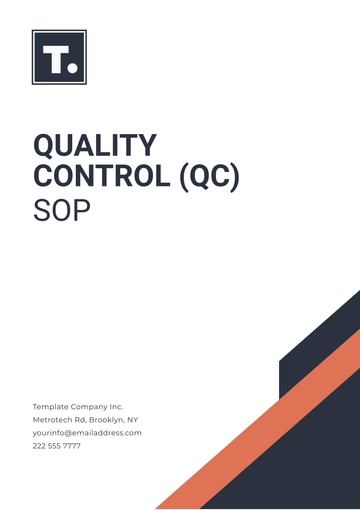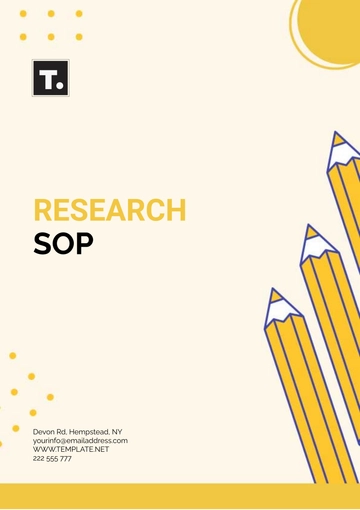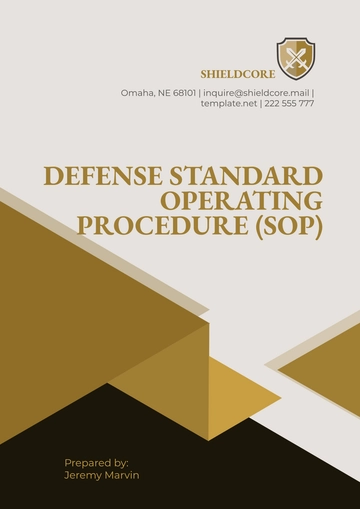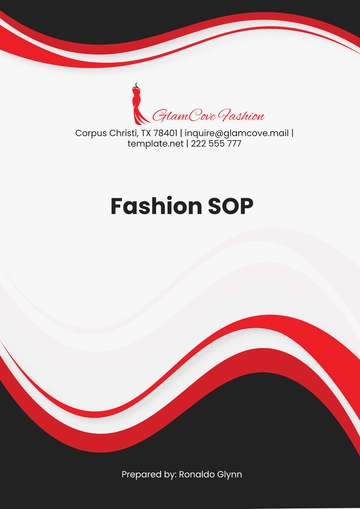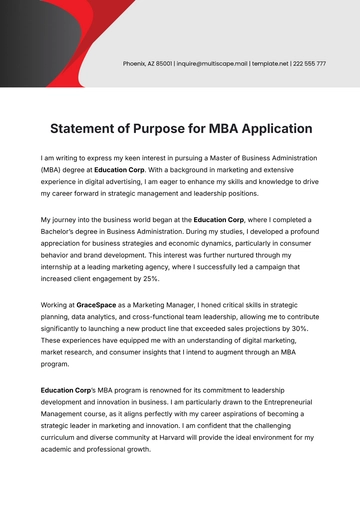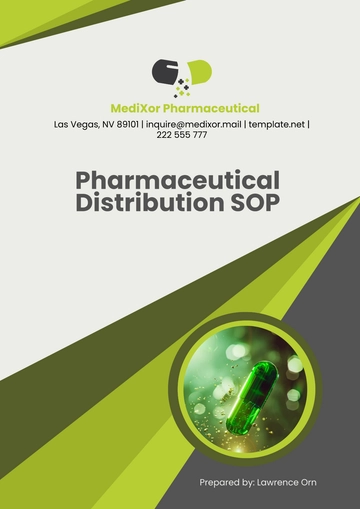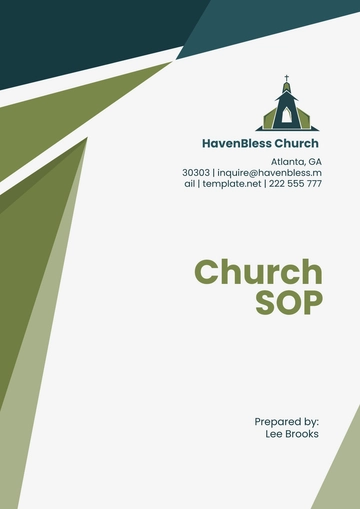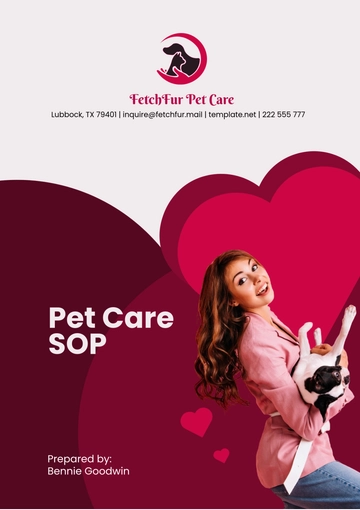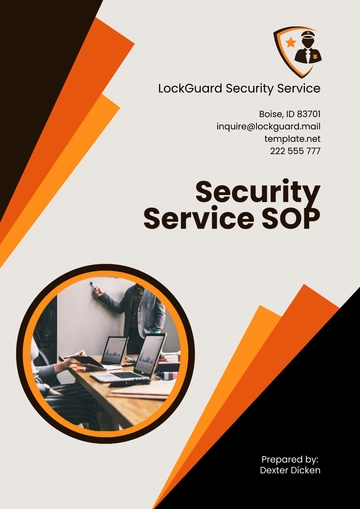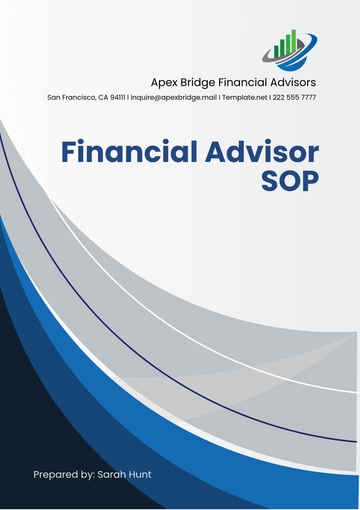Free Restaurant Safety SOP

I. Purpose
The primary objective of this Standard Operating Procedure (SOP) is to establish a framework that guarantees a secure and health-conscious workplace for all employees, and a safe dining atmosphere for our patrons at [Your Company Name]. By systematically adhering to these procedures, we aim to minimize the risk of occupational hazards, thereby enhancing the overall safety of our work settings. This comprehensive approach not only supports the wellbeing of our team but also ensures that every customer enjoys a safe dining experience, free from health risks associated with food handling and service.
These guidelines are meticulously designed to uphold the highest standards of food safety and workplace hygiene. Adherence to these standards is vital to prevent contamination and manage risks effectively, ensuring that our operations are in strict compliance with local health regulations and industry best practices. By fostering a culture that prioritizes cleanliness and systematic processes, we reinforce our commitment to quality and safety. This dedication is critical in maintaining the trust and loyalty of our customers, which is paramount to our success.
Furthermore, this SOP serves as a fundamental component of our legal and ethical obligations at [Your Company Name]. Compliance with these guidelines is not only mandatory for regulatory approval but also pivotal in cultivating an environment that values safety above all. By integrating these practices into our daily operations, we promote a culture of proactive safety management, where continuous improvement and adherence to health standards are ingrained in every aspect of our business. This commitment extends beyond mere compliance, aiming to set a benchmark for excellence in restaurant safety and hygiene.
II. Scope
This Standard Operating Procedure (SOP) is universally applicable to all members of the workforce at [Your Company Name], encompassing full-time and part-time employees, contractors, and temporary staff. It ensures that everyone involved in our operations, irrespective of their role or duration of their contract, is familiar with and adheres to our health and safety protocols. This inclusive approach guarantees that all personnel are uniformly trained and committed to upholding the standards necessary for maintaining our reputation for safety and cleanliness.
The scope of this SOP also extends to any new hires and seasonal workers who join [Your Company Name] throughout the year. By integrating this SOP into our initial training programs, we ensure that from the very start, all team members are equipped with the knowledge and skills needed to perform their duties safely and efficiently. This policy is critical for creating a consistent safety culture across all levels of the organization, ensuring that every individual understands their role in promoting and maintaining workplace safety and health standards.
Moreover, the provisions of this SOP are binding for all external entities that interact with our business processes, including vendors and service providers. By mandating compliance with our health and safety guidelines, we safeguard our operational integrity and minimize risk exposure. This rigorous standard helps us maintain control over the quality and safety of our services, making [Your Company Name] a leader in the industry for both employee welfare and customer satisfaction.
III. Responsibilities
The responsibilities section of our Standard Operating Procedure (SOP) clearly delineates the roles and duties of various stakeholders within [Your Company Name]. This allocation ensures that all parties involved are aware of their specific contributions towards maintaining a safe and healthy work environment. The table below details the responsibilities assigned to management, employees, and the Health and Safety Officer, ensuring comprehensive understanding and accountability across the organization.
Stakeholder | Responsibilities |
|---|---|
Management |
|
Employees |
|
Health and Safety Officer |
|
Each role within our organization carries specific responsibilities that contribute to a culture of safety and compliance. By defining these duties clearly, we foster an environment where safety protocols are not just followed but integrated into our daily operations.
IV. Safety Training
Safety training is a pivotal component of our Standard Operating Procedure (SOP) at [Your Company Name], designed to ensure that all employees are equipped with the necessary knowledge and skills to maintain a safe working environment. The comprehensive training programs outlined below are mandatory for all staff members, reinforcing our commitment to safety and compliance. Each program focuses on critical aspects of workplace safety, from equipment handling to hygiene practices.
Training Program | Description | Frequency |
|---|---|---|
Equipment Handling | This program teaches proper techniques for using kitchen and service equipment, reducing the risk of accidents. | Upon induction and annually |
Emergency Response | Employees learn how to act in emergency situations, including fire safety, evacuation procedures, and first aid. | Initially and bi-annually |
Food Safety and Hygiene | Focuses on preventing foodborne illnesses through proper handling, cooking, and storage of food. | Annually |
Regular Refresher Courses | These courses ensure that all staff members are up-to-date with the latest safety protocols and procedures. | Every six months |
Through these structured training programs, we not only comply with health and safety regulations but also foster a proactive culture of safety awareness and responsiveness among our staff. This structured approach ensures that every team member at [Your Company Name] can contribute to a safe and efficient working environment.
V. Equipment Handling
Ensuring proper handling and usage of equipment at [Your Company Name] is crucial for preventing injuries and maintaining a safe working environment. The following table summarizes the key procedures that all employees must follow when interacting with any equipment. These guidelines are designed to mitigate risks and enhance safety through proper practices, from using protective gear to adhering to manufacturer instructions.
Procedure | Description | Rationale |
|---|---|---|
Use Protective Gear | Employees must wear appropriate protective gear, such as gloves and aprons, when operating any equipment. | To protect against burns, cuts, and other potential injuries. |
Check Equipment Condition | Before using any equipment, check that it is in good working condition. | To prevent accidents caused by malfunctioning equipment. |
Report Faulty Equipment | Immediately report any signs of malfunction or wear to management without attempting repairs or adjustments. | To ensure timely repair or replacement and maintain safety. |
Follow Manufacturer Guidelines | Always operate equipment according to the guidelines provided by the manufacturer. | To ensure equipment is used safely and as intended. |
By adhering to these structured equipment handling procedures, employees at [Your Company Name] not only safeguard their own wellbeing but also contribute to the overall safety culture of the restaurant. This proactive approach to equipment safety is integral to preventing workplace injuries and ensuring operational efficiency.
VI. Emergency Response
At [Your Company Name], the safety of our employees and patrons is paramount. To effectively respond to any emergency situation, we have established a set of procedures outlined in the table below. These steps are designed to ensure a swift and coordinated response, minimizing harm and addressing potential threats efficiently.
Step | Action | Purpose |
|---|---|---|
Call Emergency Services | Dial 911 immediately in the event of medical emergencies, fires, or other life-threatening situations. | To ensure professional help is on the way as quickly as possible. |
Notify Management | Inform the Health and Safety Officer and Management without delay. | To initiate internal emergency protocols and assist in managing the situation. |
Evacuate the Premises | Follow the designated evacuation plan calmly and orderly. | To ensure all personnel and patrons are safely removed from potential danger. |
Use Fire Extinguishers | If trained, use fire extinguishers to tackle small fires that are safe to manage. | To attempt to control or extinguish small fires before they escalate, without risking personal safety. |
Administer First Aid | Provide first aid assistance if you are trained and it is necessary, until professional medical help arrives. | To offer immediate care to those injured, potentially reducing the severity of injuries. |
By following these emergency response procedures, employees at [Your Company Name] can effectively manage critical situations with clarity and confidence. This structured approach ensures that every team member knows their role during an emergency, enhancing the overall safety of our environment.
VII. Food Safety Standards
Maintaining strict food safety standards at [Your Company Name] is essential to prevent contamination and ensure the highest quality of food served to our customers. The table below outlines the key standards that all employees must adhere to in order to minimize risks and maintain our commitment to health and hygiene.
Standard | Description | Purpose |
|---|---|---|
Hand Washing | Employees must wash hands thoroughly with soap and water for at least 20 seconds before handling any food items. | To eliminate germs and prevent the spread of foodborne illnesses. |
Temperature Control | Store all food items at appropriate temperatures according to safety guidelines to prevent bacterial growth. | To ensure food is stored safely, preserving its quality and safety. |
Expiration Monitoring | Regularly check and document expiration dates of all food items; dispose of any that are expired. | To prevent the use of spoiled or harmful ingredients in food preparation. |
Prevent Cross-Contamination | Use separate cutting boards and utensils for raw and cooked foods to prevent cross-contamination. | To avoid transferring harmful bacteria from raw to ready-to-eat foods. |
Glove Usage | Wear gloves when handling ready-to-eat foods and change gloves between tasks to maintain cleanliness and safety. | To protect food from direct contact with hands, further reducing contamination risks. |
By strictly following these food safety standards, employees at [Your Company Name] ensure that our food preparation processes are safe, hygienic, and consistent with public health regulations. This dedication to safety helps us maintain the trust and satisfaction of our customers, reinforcing our reputation for quality.
VIII. Cleaning Protocols
At [Your Company Name], maintaining a hygienic environment is critical for both safety and customer satisfaction. Our cleaning protocols are structured to ensure that every area of the restaurant is consistently clean and sanitary. The table below provides a detailed breakdown of these protocols, highlighting the practices we follow to keep our premises in top condition.
Protocol | Description | Purpose |
|---|---|---|
Sanitize Workstations | Clean and sanitize all workstations before and after each shift using approved sanitizing agents. | To prevent the buildup of bacteria and ensure a clean working environment for food preparation. |
Structured Cleaning Schedule | Adhere to a detailed cleaning schedule that specifies daily, weekly, and monthly tasks for different areas. | To ensure all parts of the restaurant are regularly cleaned and maintained, preventing any hygiene issues. |
Regular Trash Disposal | Dispose of trash and waste regularly throughout the day and use proper waste disposal methods to manage refuse. | To minimize odors and reduce the risk of pest infestations. |
Use of Approved Cleaning Agents | Utilize only cleaning agents that have been approved for use in food service areas and follow the manufacturer’s instructions for effective use. | To ensure safe and effective cleaning that complies with health regulations and protects surfaces against damage. |
By adhering to these cleaning protocols, [Your Company Name] ensures that our restaurant remains a welcoming and safe environment for both our customers and staff. This rigorous approach to cleanliness not only meets but often exceeds local health department standards, contributing to our reputation for quality and care.
IX. Monitoring and Compliance
Ensuring adherence to our Standard Operating Procedures (SOP) at [Your Company Name] is essential for maintaining our high standards of safety and quality. The monitoring and compliance mechanisms detailed below are designed to ensure that all employees consistently follow our established procedures and that any necessary updates are effectively implemented.
Component | Description | Purpose |
|---|---|---|
Regular Audits | The Health and Safety Officer will conduct regular audits to assess adherence to the SOP and identify areas of improvement. | To ensure ongoing compliance and prompt identification of potential issues before they escalate. |
Disciplinary Actions | Employees found not adhering to the SOP will face disciplinary actions, which may include retraining, written warnings, or other measures depending on the severity of the infraction. | To reinforce the importance of compliance and maintain a safe working environment. |
Communication of Updates | Any updates to the SOP will be communicated to all staff promptly, with additional training provided as necessary to ensure understanding and implementation. | To ensure all team members are informed of changes and equipped with the knowledge to follow new guidelines effectively. |
Through these monitoring and compliance strategies, [Your Company Name] ensures that every member of our team is accountable and informed, fostering a culture of safety and excellence that upholds our commitment to our employees and customers. This structured approach not only helps maintain compliance but also supports continuous improvement in our operations.
X. Record Keeping
At [Your Company Name], maintaining detailed records is an integral part of our operational procedures, allowing us to track compliance, monitor effectiveness, and ensure accountability within our workplace. The table below outlines the key records we keep, their specific purposes, and how they contribute to our overall management and safety protocols.
Record Type | Description | Purpose |
|---|---|---|
Training Records | Document completion and attendance of all safety and operational training sessions for each employee. | To verify that all employees have received and understood necessary training, ensuring compliance and competence. |
Incident and Accident Reports | Keep detailed reports of any incidents or accidents that occur, including the date, time, participants, and description of the event. | To analyze incidents for patterns and prevent future occurrences, ensuring continuous improvement in safety measures. |
Equipment Maintenance Logs | Maintain logs of all maintenance activities performed on equipment, including dates, details of the service, and the technician’s name. | To ensure equipment is regularly and properly maintained, reducing the risk of malfunctions and accidents. |
Cleaning Schedules and Logs | Record all cleaning activities, detailing what was cleaned, by whom, and when, following the established cleaning schedule. | To monitor the cleanliness and sanitation of the facility, ensuring it meets health and safety standards at all times. |
By diligently maintaining these records, [Your Company Name] upholds a high standard of operational transparency and accountability. This rigorous record-keeping process not only helps in regulatory compliance but also enhances our ability to manage the business effectively, ensuring a safe and professional environment for both staff and customers.
For any issues or concerns, please contact [Your Company's Health and Safety Officer] at [Your Company Email] or [Your Company Number].
- 100% Customizable, free editor
- Access 1 Million+ Templates, photo’s & graphics
- Download or share as a template
- Click and replace photos, graphics, text, backgrounds
- Resize, crop, AI write & more
- Access advanced editor
Ensure the safety of your restaurant staff and customers with Template.net’s Restaurant Safety SOP Template. This fully customizable and editable template, editable in our AI Editor Tool, provides a comprehensive safety plan. Crafted with precision, it enhances operational efficiency, promotes compliance, and mitigates risks. Elevate your safety protocols today and maintain the highest standards effortlessly.




